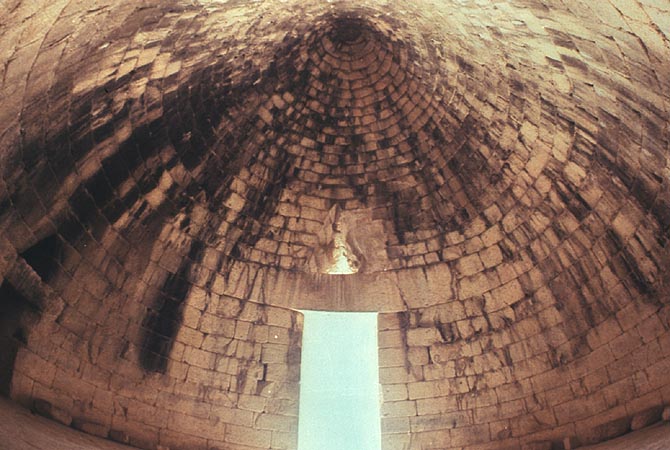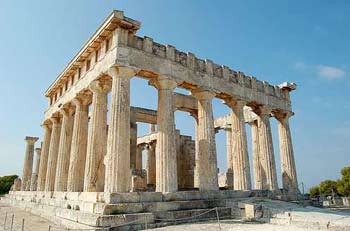|
Pithoi Large storage containers for grain, honey, oils or wine. From the Palace at Knossos on Crete Minoan |

|
|
Minoan Column from Palace at Knossos Top circular nub called the capitol Minoan |

|
|
Dolphin Fresco c. 1500 BC Dolphins are stylized From Queen's megaron at Knossos Minoan |

|
|
King Minos's Throne Room From Palace at Knossos Freaky hybrid animals Spirals Prevalent Minoan |

|
|
Cup Bearers Fresco c 1500 BC From Palace at Knossos Figures in procession creates ongoing narration Minoan figure style: mostly in profile, deemphasized eyes, fluid figure, thin waists, jewelery, curly hair Minoan |

|
|
La Parisienne Fresco fragment from Knossos Minoan |

|
|
Toreador Fresco Bull ritual depicted c 1500 BC Bull is revered and prevalent in their art Minoan |

|
|
Octopus jar From Gournia in east Crete c 1600 BC Composition: design adjusted so tentacles follow contours of vase Minoan |

|
|
Snake Goddess From Knossos c. 1600 BC Domineering posture Open form (arms extended from body) Dress depicts contemporary fashion Minoan |

|
|
Lion Gate From Mycenae (Palace of Agamemmnon) c 1300 BC Corbeled arch: bricks slanted to form triangular wedge at top Stones were 20 feet thick Mycenaean |

|
|
Treasury of Atreus Tomb Beehive ceiling structure - multiple concentric circles Tholos: Round architectural plan Corbeled arch Mycenaean |

|
|
Entrance to Treasury of Atreus Dromos: Entrance to a tomb flanked by stone walls Mycenaean |

|
|
Funeral Mask (of Agamemmnon) c. 1500 BC Placed on the face of the deceased in funerary ritual Repousse: Malleable metal (gold) is hammered into relief from reverse side Mycenaean |

|
|
Warrior Vase c. 1300-1200 BC Style + figure dress similar to art of Asia Minor Supports theory of migration Mycenaean |

|
|
Altar of Zeus c. 530 BC Caryatid (female sculpture) supports From Treasury of Siphnians at Delphi Continuous frieze at top Hellenistic |

|
|
Battle of Gods & Giants c. 530 BC From Altar of Zeus in the Treasury of the Siphnians Has something to do with watching Trojan War? Hellenistic |

|
|
Temple of Aphaia From Aegina c. 500-490 BC Pedimental sculptures: turning point between Late Archaic and Early Classical Cult of Aphaia worshipped here Late Archaic |

|
|
Archer (Herakles) From pediment of Temple of Aphaia at Aegina c. 500-490 BC Heroic pride manifested in artistic styles Late Archaic |

|
|
Dying Warrior From Pediment of Temple of Aphaia at Aegina c. 500-490 BC Cult of Aphaia worshipped here Heroic pride of Archaic culture Late Archaic |

|
|
Poseidon (Bronze) c. 460 BC Made using cire perdue or 'lost wax' process Open form Exhibits Classical 'severe style': strong + intense igure, rigid posture, stern expression Early Classical |

|
|
Charioteer of Delphi c. 470 BC Naturalistic, greater detail than before Calm expression Early Classical |

|
|
Pediment of Temple of Zeus Center: Apollo calmly ordering centaurs to stop Left of Apollo: Hippodamia and Centaur exemplify ideal of calm Greeks vs. angry + vicious Barbarians; composition example of dynamic balance Symbolized 3 things: 1) Greek victory over Persians 2) Sacred Truce of Olympia (during Olympic games) 3) Responsibility of men to acknowledge laws Early Classical |

|
|
Acropolis of Athens On giant hill in center of Athens Gateway: Propyleae Parthenon: main temple; designed and constructed in 9 years by architects Iktinos & Kallikrates Peripteral: a temple that has a single row of columns on all four sides Cella (Latin)/Naos (Greek): center, innermost chamber of a temple, usually containing main statue High Classical |

|
|
Apollo from Parthenon pediment Marble Sculpted by Phidias High Classical |

|
|
Three Goddesses From Parthenon pediment c. 438-432 BC Demeter, Persephone and Isis Modeling line: squiggly line that (allegedly) ties the three figures together Illusion of transparency: floaty gauze fabric worn by figures High Classical |

|
|
Lapith & Centaur (fighting) From metope of Parthenon South wall High relief High Classical |

|
|
Temple of Athena Nike c. 425 BC On Acropolis, near Parthenon (Athens) Designed by Iktinos & Kallikrates Amphiprostyle: Porticos (porch with roof) in front and rear of temple, with flat, columnless walls on the sides High Classical |

|
|
Nike (Victory) Fastening Her Sandal c. 425 BC Somewhere around Temple of Athena Nike Marble relief Illusion of floaty fabric High Classical |

|
|
Erechtheum c. 421-405 BC Also on Acropolis Asymmetrical: built on 5 different levels Southern porch: Porch of Maidens, has caryatids for columns Somehow related to struggle between Athena and Poseidon High Classical |

|
|
Discobolos c. 450 BC Twisted counterbalance Symbol of the perfect Greek man: sound mind with a sound body Sculptor: Myron Severe style On 2-D plane - only one view to properly appreciate piece High Classical |

|
|
Doryphoros c. 450 BC Bulky figure Motion implied at rest Contrapostal stance - "Kritios Boy grown up" Sculptor: Polykleitos (canon for male figure) High Classical |

|
|
Hermes with Infant Dionysos c. 330-320 BC Increased humanization: double weight shift, elongated torso and legs Sculptor: Praxiteles Open form First instance of true interaction between figures Late Classical |

|
|
Apoxyomenos (Scraper) c. 330 BC Even taller, more slender, + more flexible figure Sculptor: Lysippos Occupies 3-D space (not just in a single plane), multiple interesting viewing perspectives Late Classical
|

|
|
Aphrodite of Cnidos c. 350 BC First life-size female nude Scupltor: Praxiteles (canon for female nude figure) 3-D space Late Classical |

|
|
Nike of Samothrace c. 190 BC Spirals created by agitated flowing cloth on figure Meant to be on prow of a ship Hellenistic |

|
|
Dying Gaul c. 240 BC Body follows single long diagonal - creates tension in figure Twisted at shoulders + hips - spiral Example of reach of Greek conquest School of Pergamon More diversity in idea of beauty Depicted as nude: sign of dignity in Greek sculpture Hellenistic |

|
|
Laocoon Anguished expressions Snake + twisted bodies create spiral and tension Hellenistic |

|
|
Venus de Milo S Curve of body - more drastic weight shift than contraposto More diversity in perceived idea of beauty - not just male Greek warriors + gods who are being sculpted Hellenistic |

|
|
Kritios Boy Contraposto stance - weight shift on one foot creates dynamic, relaxed appearance Signal of end of Archaic period Early Classical |

|